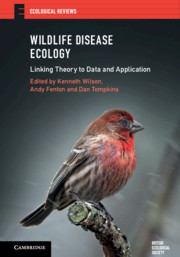Book contents
- Wildlife Disease Ecology
- Ecological Reviews
- Wildlife Disease Ecology
- Copyright page
- Contents
- Contributors
- Preface: Wildlife Disease Ecology
- Glossary of Terms
- Part I Understanding within-host processes
- Part II Understanding between-host processes
- Part III Understanding wildlife disease ecology at the community and landscape level
- Chapter Fifteen The ecological and evolutionary trajectory of oak powdery mildew in Europe
- Chapter Sixteen Healthy herds or predator spreaders? Insights from the plankton into how predators suppress and spread disease
- Chapter Seventeen Multi-trophic interactions and migration behaviour determine the ecology and evolution of parasite infection in monarch butterflies
- Chapter Eighteen When chytrid fungus invades: integrating theory and data to understand disease-induced amphibian declines
- Chapter Nineteen Ecology of a marine ectoparasite in farmed and wild salmon
- Chapter Twenty Mycoplasmal conjunctivitis in house finches: the study of an emerging disease
- Chapter Twenty-one Processes generating heterogeneities in infection and transmission in a parasite–rabbit system
- Chapter Twenty-two Sylvatic plague in Central Asia: a case study of abundance thresholds
- Index
- Plate Section (PDF Only)
- References
Chapter Seventeen - Multi-trophic interactions and migration behaviour determine the ecology and evolution of parasite infection in monarch butterflies
from Part III - Understanding wildlife disease ecology at the community and landscape level
Published online by Cambridge University Press: 28 October 2019
- Wildlife Disease Ecology
- Ecological Reviews
- Wildlife Disease Ecology
- Copyright page
- Contents
- Contributors
- Preface: Wildlife Disease Ecology
- Glossary of Terms
- Part I Understanding within-host processes
- Part II Understanding between-host processes
- Part III Understanding wildlife disease ecology at the community and landscape level
- Chapter Fifteen The ecological and evolutionary trajectory of oak powdery mildew in Europe
- Chapter Sixteen Healthy herds or predator spreaders? Insights from the plankton into how predators suppress and spread disease
- Chapter Seventeen Multi-trophic interactions and migration behaviour determine the ecology and evolution of parasite infection in monarch butterflies
- Chapter Eighteen When chytrid fungus invades: integrating theory and data to understand disease-induced amphibian declines
- Chapter Nineteen Ecology of a marine ectoparasite in farmed and wild salmon
- Chapter Twenty Mycoplasmal conjunctivitis in house finches: the study of an emerging disease
- Chapter Twenty-one Processes generating heterogeneities in infection and transmission in a parasite–rabbit system
- Chapter Twenty-two Sylvatic plague in Central Asia: a case study of abundance thresholds
- Index
- Plate Section (PDF Only)
- References
Summary
Monarch caterpillars are specialist feeders on milkweeds, from which they sequester toxic cardenolides, protecting them against predators. Their bright colours advertise toxicity. North American monarchs make an annual migration; millions of them travel from the USA and Canada to overwinter in central Mexico. They are an ideal system to study the effects of multitrophic interactions and migration behaviour on the ecology and evolution of infectious disease. Monarchs are commonly infected with a protozoan parasite. Our studies have shown that milkweed chemicals reduce parasite growth, transmission, and virulence and are used by monarchs to reduce infection in their offspring, although this may also select for more virulent parasites. Studies have also shown that seasonal migration is an important determinant of parasite prevalence through migratory culling, when the most heavily infected individuals are weeded out during the autumn migration, and migratory escape, when they escape contaminated environments, reducing infection probability. Conservation efforts have increased the planting of non-native medicinal milkweeds in North America, and monarchs have increasingly formed sedentary populations, reducing migration rates. This has increased parasite prevalence in non-migratory populations. Integrating studies on multitrophic interactions and migration behaviour are necessary to determine their long-term effects on parasite dynamics and host and parasite evolution in monarchs.
Keywords
- Type
- Chapter
- Information
- Wildlife Disease EcologyLinking Theory to Data and Application, pp. 480 - 510Publisher: Cambridge University PressPrint publication year: 2019
References
- 3
- Cited by

